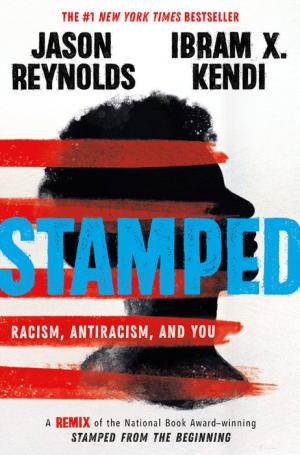
Stamped: Racism, Antiracism, and You
Written by Jason Reynolds and Ibram X. Kendi
Little, Brown and Company, 2020, 294 pp
ISBN: 978-0-316-45369-1
As seen in the Black Lives Matter marches and protests throughout the summer of 2020, systemic racism is prevalent throughout the United States. Jason Reynolds and Ibram Kendi (2020) ask, “whether you, reader, want to be a segregationist (a hater), an assimilationist (a coward), or an antiracist (someone who truly loves)” (p. 247). Throughout the book, a history of Black America is told through the lens of Black Americans: the broken pathway from segregationists to assimilationists to the possible antiracist future.
The authors purport that this is NOT a history book. But Jason Reynolds, as a young adult author, and Ibram Kendi, as a historian, have a marvelous way of presenting historical material in a way that makes young adult readers want to read the book. The quantity of detail invites readers to absorb the history throughout the book. Short, direct chapters divided into five sections lead readers from the beginnings of racist thoughts with Zurara, a fifteenth century novelist credited as the first defender of African slave trading, to the antiracist possibilities offered by Angela Davis, a modern antiracist academic.
While the sections are divided by dates rather than themes, some themes emerge from the five sections. The first section, 1415-1728, details the beginnings of academic, religious, and scientific arguments for white superiority. The second section, 1743-1826, goes through some of the segregationist ideas that upheld a racial hierarchy, including the belief that the just thing to do was maintaining the hierarchy for the benefit of Blacks. The third section, 1826-1879, shows the liminal period in United States history when abolitionists were mostly segregationists or assimilationists but generally not antiracists. The fourth section, 1868-1963, demonstrates the movement of Blacks toward an assimilationist viewpoint that if they can only do better, they will be accepted in society. The fifth section, 1963-Today, details the systemic issues that keep segregationist and assimilationists in power while perpetuating those beliefs among minoritized individuals. This last section ends with the rejection of a racist future in Black Lives Matters protests.
Jason Reynolds is the primary author of what he calls a “remix” of Kendi’s 2017 National Book Award-winning Stamped from the Beginning. Through Kendi’s work as a historian, they provide notes on sources including primary sources such as letters and laws, news articles, and academic texts for students to further explore the presented ideas. These ideas serve as a counternarrative to the majoritized perspective of what it means to be Black in America and history from a Black point of view. This text is in line with other similar texts such as Howard Zinn’s A People’s History of the United States (1980) or Paul Ortiz’s An African American and Latinx History of the United States (2018), except Stamped is much more young adult friendly. Stamped has many more entry points for young adult readers, which hooks them into exploring the ideas and yearning for more knowledge (and reading).
The authors provide a list of books for further reading including March (Books 1-3) by the late Congressman John Lewis (2013), The Hate U Give by Angie Thomas (2017), and The Bluest Eye by Toni Morrison (1970). While these suggested books offer a variety of sources from graphic novels, contemporary novels, and works from the canon, other possibilities might engage students with the history of racism in the United States. Some possibilities with picturebooks include Something Happened in Our Town by Marianne Celano, Marietta Collins, and Ann Hazzard, illustrated by Jennifer Zivion (2018), Skin Again by bell hooks and illustrated by Chris Raschka (2004), and Not My Idea: A Book about Whiteness by Anatasia Higgginbotham (2018). Some texts that might extend the learning from Stamped could be This Book Is Antiracist by Tiffany Jewell and Aurelia Durand (2020), The Fire Next Time by James Baldwin (1963), or I Know Why the Caged Bird Sings by Maya Angelou (1969).
As a young adult, Jason Reynolds was inspired by Queen Latifah’s album Black Reign (1993), which led him to write for young adults who, like him, did not like to read. His books such as Ghost (2016) and As Brave as You (2016), offer sliding doorways to Black boys into the world of literature. Ibram Xolani Kendi, as the director of the Center for Antiracist Research, offers historical counternarratives to racist ideals to children in Antiracist Baby (2020), to adults in How to Be an Antiracist (2019), and to young adults in this nonfiction book.
Victor Lozada, Texas Woman’s University
© 2021 by Victor Lozada

WOW Review, Volume XIII, Issue 3 by Worlds of Words is licensed under a Creative Commons Attribution-NonCommercial-ShareAlike 4.0 International License. Based on work by Victor Lozada at https://wowlit.org/on-line-publications/review/volume-xiii-issue-3/8/
